This book provides an illustrated history of narrow gauge railways in the state of Saxony in eastern Germany, many of which still see commercial steam-hauled trains every day.
Published in March 2023 by Amberley Publishing and written by John Woodhams, this soft cover book measures around 23.4 cm x 16.5 cm, and has 96 pages and 140 illustrations. It has a published price of £15.99 although Amberley Publishing currently has it on offer at £14.39, and at the time of writing, it can be obtained from Amazon for £11.89.
The first thing to say about this book is that it is not a collection of photographs in the usual Amberley style, but a well-written description of the evolution of narrow gauge railways in Saxony, supplemented by an incredible collection of historical photographs.
With six chapters, this book follows the history of Germany over the last 150 years, with Chapter 1 describing “The Development of the Saxon State Railway Narrow Gauge”. Chapter 2 covers the “Two World Wars and the Reichsbahn Takeover; 1914-45”, followed by: “Behind the Iron Curtain: 1945-90; “reunification and After”; Locomotives and Rolling Stock”; and “Other Narrow Gauge Railways”,
The book concludes with a very useful Appendix listing railways and museums to visit, and thoughtfully provides the website addresses of each.
Unlike Britain, where the early railways evolved under different companies, we find that these lines were all originally operated by the Royal Saxon State Railway company, which later became the federal government railway, although after the Second World War the Soviet Union claimed some of the railway assets as reparations when the area became part of the German Democratic Republic.
Like Britain’s railways before the Beeching Report, many of the lines served small towns and villages and closed in the 1960s. but those that were still running when the Berlin Wall collapsed in 1989 still survive. John Woodham’s descriptions are enhanced by his fascinating selection of historic images that provide a wonderful insight into these railways that rekindle memories of the days of steam.
The Introduction includes the useful map shown below, although the limited size format of the book has necessitated it to be printed sideways. On the right is the first page of chapter 1, which clearly shows the fine depth of description to be found throughout the book.
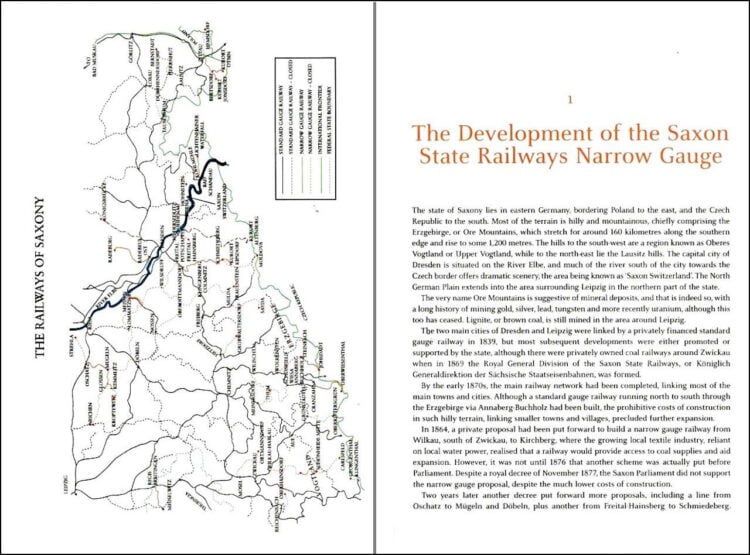
The photos below are examples of the excellent historical photographs that the author has managed to include, with each of these dating back to the 1890s.
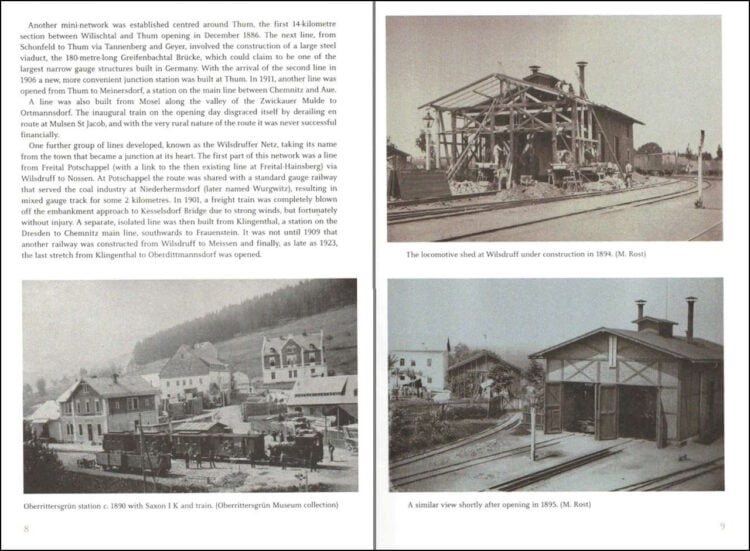
Steam locomotives working in winter are usually guaranteed to produce photogenic smoke effects, as seen below.
What is remarkable that these are working on normal daily commercial services. On the right is a scene that is historic, not for the train but for the Trabant motor car, which more or less monopolised private motor transport in the days of the German Democratic Republic but are now historical rarities.
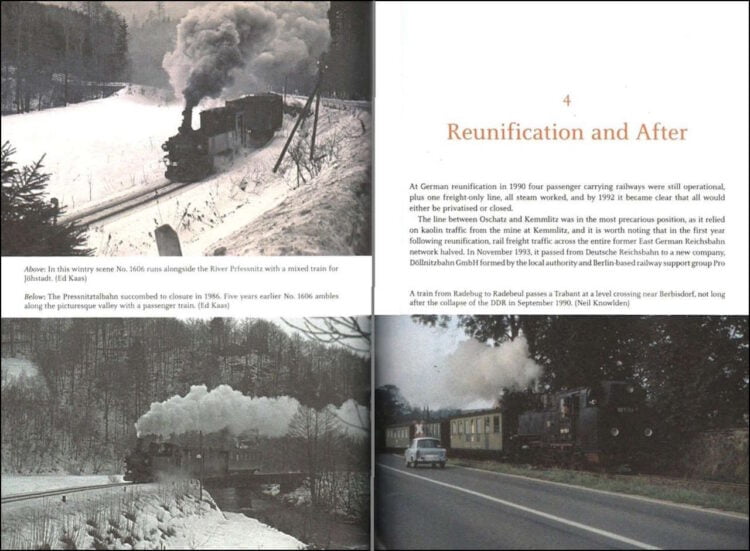
Typical of the rural byways through which the railways operate are the scenes below. The bottom left photo is especially interesting as the length of rail on the wagon behind the locomotive shows it to be an operational train, yet it has stopped en route to top up with water from a handy lineside hose.
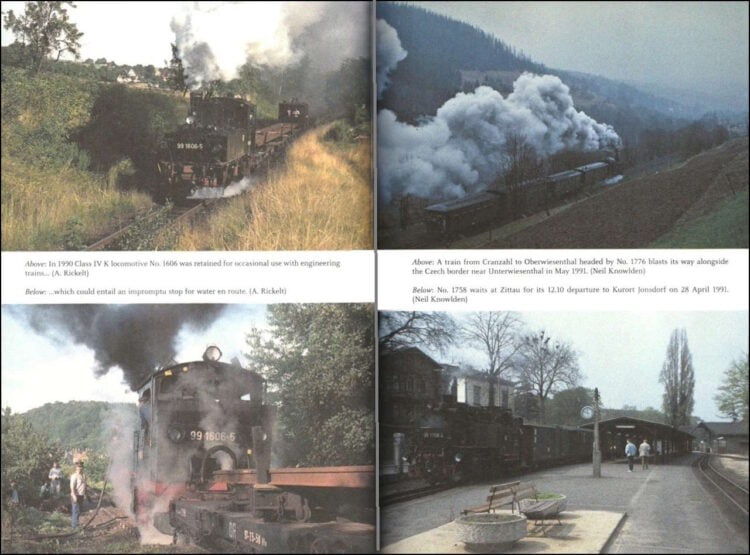
One of the major differences with UK railways is the absence of lineside fences as in the photo at the bottom right, while the continued investment in Saxony’s narrow-gauge railways can be seen at the top right with what is a new workshop.
As in the first pages in this sample, the left-hand page below continues to demonstrate the depth of detail in the author’s narrative.
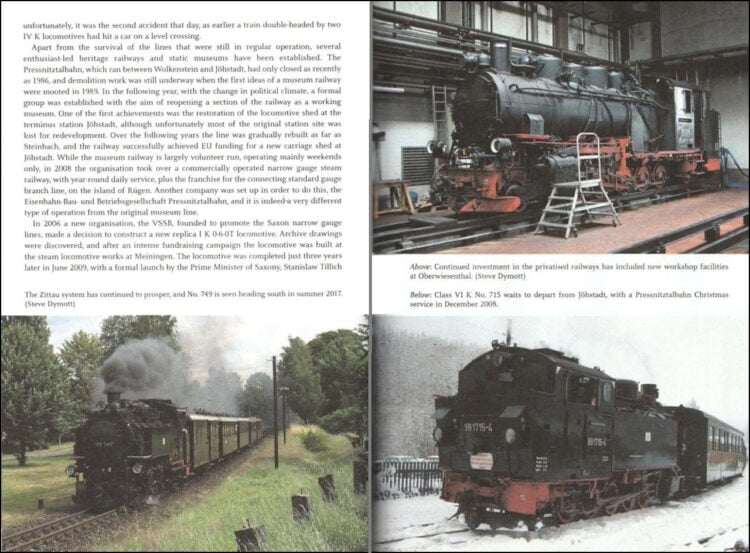
This book presents a refreshing change from the usual Amberley style of a purely photographic presentation supplemented by concise captions. Here is a well-written description where photographs enhance rather than overwhelm the text. Mention must also be made of the remarkable historical photographs, some of them dating back to the 1890s.
The narrative achieves the right balance between historical details and developments of the railways. The result is a thoroughly entertaining book following the development of narrow-gauge railways through the various upheavals in German history until the present day.
A useful addition is an Appendix that lists railways and museums in Saxony with the website addresses of each.
A minor criticism is the map included in the Introduction which is printed sideways
With some of the railways still operational and running commercial services daily, there is a good selection of photographs of steam locomotives working in winter producing photogenic smoke effects. There are also scenes from typical of the rural byways, and the difference in working practices from Britain’s railways.
With many rail enthusiasts visiting Germany each year to experience the thrill of travelling behind steam on its narrow-gauge railways, this book is essential reading before travelling and as an addition to holiday luggage.
The book is available to purchase from Amazon and from Amberley Publishing.
We would like to thank Amberley Publishing for providing us with a copy of the book for review.






Responses